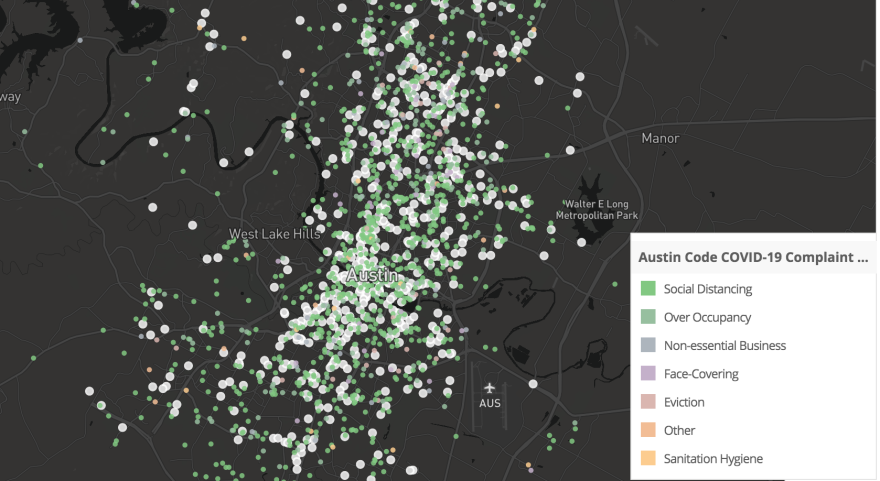Austinites complained to 311 about people – and businesses – violating the city's and county's stay-at-home orders more than 3,400 times since they were issued in March, according to recently released data from the city.
Of those thousands of complaints, two ended in someone getting a ticket – both of which were for not properly social distancing at a construction site.
Of course, that was a central conceit when the orders were issued: Austin-area authorities wouldn't be ticketing people or throwing them in jail for being out during the pandemic. The Austin Police Department even issued guidelines advising officers to rely on "voluntary compliance" to enforce the orders in early April, telling them, more or less, to educate and not incarcerate people. And the Code Department, not police, has been handling complaints coming in from 311.
From March 17 through May 12, the department fielded 3,425 calls and online submissions about folks violating the order, according to the data.

What did people complain about?
Most of the complaints centered around social distancing, or a lack thereof.
Nearly 7 in 10 of all complaints were because people were too close to one another:
- 68% of complaints were for social distancing
- 22% of complaints were for over occupancy
- 4% of complaints were about nonessential business operation
- 3% of complaints were for people not wearing facial coverings
- 1% of complaints were related to evictions
- 1% of complaints were classified as "other"
- 1% of complaints were related to sanitation or hygiene
Who's being accused of violating the orders?
As for the types of businesses accused of violating the orders, a lot are within the amorphous "other" category, which can include everything from people hanging out in a parking lot to a bar operating when it shouldn't to people not wearing facial coverings in a grocery store.
A little more than a third of complaints are labeled as such, but another third of complaints were leveled at residential properties – most often regarding people congregating despite the orders.
Complaints about activity at parks, construction sites, restaurants, school and churches were well behind:
- 35% of complaints were classified as "other"
- 33% of complaints stemmed from violations at residences
- 15% of complaints stemmed from violations at parks
- 7% of complaints stemmed from construction activity
- 5% of complaints stemmed from restaurants
- 3% of complaints stemmed from activity at schools
- 1% of complaints stemmed from activity at churches
Where did complaints come from?
All in all, the complaints were pretty equitably dispersed, though about a third came from the more centrally located districts, District 1 and 3. Complaints from Districts 1, 7, 4 and 5 all hovered around the 9-10% range:
- 18% of complaints came from District 9
- 13% of complaints came from District 3
- 10% of complaints came from District 1
- 10% of complaints came from District 7
- 9% of complaints came from District 4
- 9% of complaints came from District 5
- 8% of complaints didn't identify a district
- 7% of complaints came from District 2
- 6% of complaints came from District 10
- 5% of complaints came from District 8
- 5% of complaints came from District 6
So, what happened after people complained?
Well, not much.
Seven out of 10 complaints resulted in no evidence and code officials didn't inspect. The majority of the complaints, 22% of them, resulted in someone from the Code Department providing COVID-19 education.
The only two citations came after the Code Department received a complaint from the city's Development Services Department, which also submitted 47 other complaints. (All told, 192 additional construction-related complaints from residents were also fielded by 311.)
Code enforcement officials inspected the two sites – one at Aldrich Street near the Mueller development and another on South Congress Avenue across the street from the Texas School for the Deaf – and issued citations.
Their report suggests workers on-site weren't socially distancing or wearing facial coverings. Inspectors also found on-site bathrooms weren't appropriately spaced.
Spread of COVID-19 at construction sites has been a particular concern for city and county officials, though it's hard to pinpoint clusters because contractors and subcontractors move freely to different sites. On top of that, workers say they can't afford to forego a paycheck and some undocumented workers may fear receiving COVID-19-related health care may mean divulging their immigration status, which Austin Public Health insists is not the case.
Got a tip? Email Andrew Weber at aweber@kut.org. Follow him on Twitter @England_Weber.
If you found the reporting above valuable, please consider making a donation to support it. Your gift pays for everything you find on KUT.org. Thanks for donating today.






